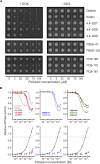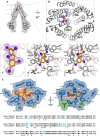Global marine pollutants inhibit P-glycoprotein: Environmental levels, inhibitory effects, and cocrystal structure
- PMID: 27152359
- PMCID: PMC4846432
- DOI: 10.1126/sciadv.1600001
Global marine pollutants inhibit P-glycoprotein: Environmental levels, inhibitory effects, and cocrystal structure
Abstract
The world's oceans are a global reservoir of persistent organic pollutants to which humans and other animals are exposed. Although it is well known that these pollutants are potentially hazardous to human and environmental health, their impacts remain incompletely understood. We examined how persistent organic pollutants interact with the drug efflux transporter P-glycoprotein (P-gp), an evolutionarily conserved defense protein that is essential for protection against environmental toxicants. We identified specific congeners of organochlorine pesticides, polychlorinated biphenyls, and polybrominated diphenyl ethers that inhibit mouse and human P-gp, and determined their environmental levels in yellowfin tuna from the Gulf of Mexico. In addition, we solved the cocrystal structure of P-gp bound to one of these inhibitory pollutants, PBDE (polybrominated diphenyl ether)-100, providing the first view of pollutant binding to a drug transporter. The results demonstrate the potential for specific binding and inhibition of mammalian P-gp by ubiquitous congeners of persistent organic pollutants present in fish and other foods, and argue for further consideration of transporter inhibition in the assessment of the risk of exposure to these chemicals.
Figures





References
-
- International Transporter Consortium Giacomini K. M., Huang S.-M., Tweedie D. J., Benet L. Z., Brouwer K. L. R., Chu X., Dahlin A., Evers R., Fischer V., Hillgren K. M., Hoffmaster K. A., Ishikawa T., Keppler D., Kim R. B., Lee C. A., Niemi M., Polli J. W., Sugiyama Y., Swaan P. W., Ware J. A., Wright S. H., Yee S. W., Zamek-Gliszczynski M. J., Zhang L., Membrane transporters in drug development. Nat. Rev. Drug Discov. 9, 215–236 (2010). - PMC - PubMed
-
- Galgani F., Cornwall R., Toomey B. H., Epel D. D., Interaction of environmental xenobiotics with a multixenobiotic defense mechanism in the bay mussel Mytilus galloprovincialis from the coast of California. Environ. Toxicol. Chem. 15, 325–331 (1996).
-
- Shabbir A., DiStasio S., Zhao J., Cardozo C. P., Wolff M. S., Caplan A. J., Differential effects of the organochlorine pesticide DDT and its metabolite p,p′-DDE on p-glycoprotein activity and expression. Toxicol. Appl. Pharmacol. 203, 91–98 (2005). - PubMed
Publication types
MeSH terms
Substances
Grants and funding
LinkOut - more resources
Full Text Sources
Other Literature Sources
Miscellaneous

